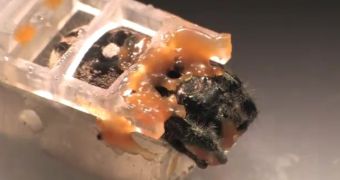For being so small (usually), spiders can be really scary. Or at least there are people who find them really, really scary to be around, especially if they pop up out of nowhere, figuratively speaking.
That didn't stop scientists from studying them though. In fact, their “scare factor” didn't stop an entire field of science from focusing on them to the exclusion of everything else.
There are people and instruments exclusively dedicated to studying their anatomy, as well as their way of life and species differences.
However, examining live specimens can be hard and frustrating, given spiders' propensity for hiding in the nearest dark cranny.
Cornell University’s Hoy Lab has the solution
A team of scientists have come up with a special harness that can hold a spider in place. And not just normal spiders, but the jumping sort. Gil Menda, Paul S. Shamble, Eyal I. Nitzany, James R. Golden, and Ronald R. Hoy are the members of said team.
They were able to use 3D printing technology to create a harness that will clamp down on them more or less harmlessly, thus preventing them from hopping away (or jumping on your face) while you're peering at them through a magnifying glass or whatever else.
The reason jumping spiders are such a fascinating object of research is their very good vision. Some may not know it, but spiders are generally very weak-sighted, and they need to build their webs and rely on them to feel around and catch their food instead of hunting.
The Phidippus audax (Latin name for the jumping spiders, though it's not a perfect translation) see almost as well as humans, despite their much smaller size, so they can stalk other insects and hunt them down eventually, especially flies and moths.
The reason harnesses are even needed is because using pins to pierce and kill them caused the creatures to burst like overinflated balloons. Being filled with tiny hydraulic systems and highly pressurized liquid (which enables them to jump), piercing their bodies tends to have that effect.
Using a harness will allow scientists to study them properly now, instead of putting a premature end to the experiments by way of subject demise.
The 3D printed harness experiment
The harness is shaped like an upper case letter “I” and is affixed over the spider with wax (a couple of drops of warm wax that quickly cool and harden). A very tiny electrode is then inserted into the spider's brain. This electrode takes readings of brain activity as objects and details are passed in front of the spider, including insects. Since each eye of a spider has a different function, this lets researchers identify those as well.

 14 DAY TRIAL //
14 DAY TRIAL //